As the technology revolution accelerates, Ryan McManus considers the leaders organizations need to succeed.
Leadership in the analog economy was relatively straightforward: competitors were largely fixed, investment flows were primarily into established companies, the pace of innovation was tame and primacy was placed on the efficiency of operations at scale.
Organizations regularly had the luxury of spending months analyzing new business opportunities in excruciating detail before starting anything new. The analog economy was much more stable, and successful leadership was largely predicated on operational management of the traditional business.
Winning in the digital economy is far more complex. Operations and scale continue to be important, of course, but as digital has revolutionized industries, competition, and business models, a new form of leadership – digital leadership – is necessary to guide organizations through the transition from analog to digital, and to thrive in the digital economy.
Clearly, this concept applies far beyond the leaders of technology functions. Digital leaders are needed in every realm of business. Digital leadership is now as critical to a leader’s skill portfolio as core financial and strategy expertise. It is the new core. Yet many organizations struggle to find leaders with the requisite combination of strategic, organizational, market and digital expertise. Digital simply hasn’t been a requirement for leadership development before now, and relatively few executives have successfully led digital transformations or built new digital businesses.
Many organizations, therefore, have plans to prioritize digital leadership as part of their executive development strategies. This article outlines the unique nature of digital leadership, based on engagements with thousands of executives globally. It also describes how digital leadership is both different from, and complementary to, more traditional management models. Digital leaders bring a portfolio of new capabilities which enable their organizations to thrive in the digital economy across four domains: strategy, expertise, execution and mindset.
Strategy
In the analog economy, digital and related technology capabilities were purely executional in relation to an organization’s strategy. Industry fundamentals had been stable for decades and the pace of change was slow.
Companies now face hundreds, if not thousands, of new competitive threats. New digital products and services enter the market nearly as quickly as companies can conceive of them. Investors fund trillions of dollars of digital bets, and companies, which fall behind risk bleeding market share and market capitalization.
Executives who rely exclusively on the leadership and strategy playbooks, which worked so well in the analog economy risk missing these fundamental changes.
The old playbooks have been exhausted.
Strategy beyond automation
Digital leaders understand the disruptive potential of technology, in particular the potential for digital business models to upend existing markets. Executives need to understand the applications of digital capabilities in terms of their fullest strategic impact. In many cases, this means going beyond traditional ways of thinking about technology-driven automation.
While automation of business processes remains an important element of successful digital businesses, many executives make the mistake of confusing automation for transformation. This runs the risk of ceding opportunities to competitors which use technology to bring materially different value propositions to market. In order to avoid anchoring digital strategies in automation, digital leaders bring a multi-tiered approach to strategy:
- Functional strategies – How do we use digital to make our processes more efficient?
- New value propositions – How do we use digital to enhance existing products and services? What new digital-first product and service opportunities would bring value to our customers?
- New business models – Who are our new and future competitors? What challenges could emerging digital capabilities pose to our economics and pricing? What are our customers’ “jobs to be done?” How do we develop and work with a digital ecosystem?
By explicitly working across these multiple levels, digital leaders engage the full enterprise in digital transformation.
Key to developing new strategies for the enterprise is the openness of digital leaders to challenge the organization’s traditional models and approaches, such as those described in Table 1. Digital leadership requires revisiting the established orthodoxy and challenging ideas and practices which, in some cases, have underpinned entire industries for decades.
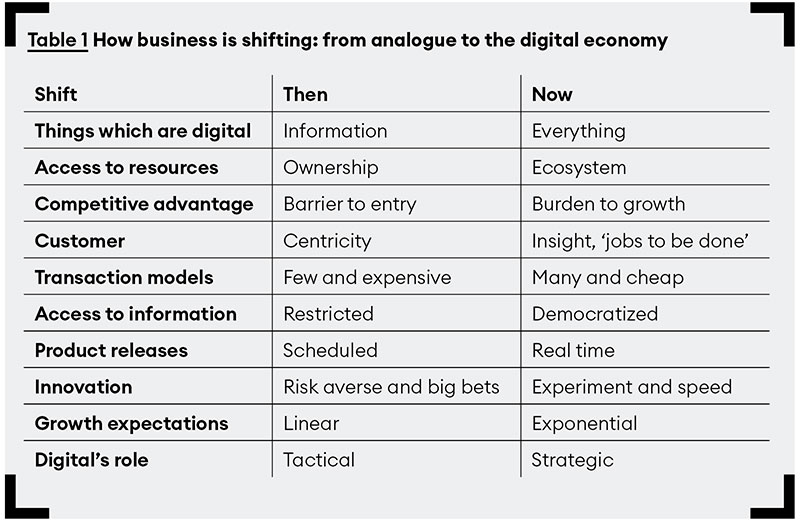
Expertise
In order to challenge existing models, digital leaders must first understand the new opportunities available through new technologies. It is a pre-requisite for leaders to possess at least a basic mastery of the technology domains which have primary relevance to their industries. Artificial intelligence (AI), the internet of things (IoT), blockchain, 5G, social media, e-commerce and other technology domains represent different opportunities and risks across sectors.
While executives don’t need to be engineers or developers, they should understand the main applications and leading examples of deployments in and around their sectors. For more on the key technologies, see Mark McDonald’s brief guide to digital technology.
Execution
The volume of digital activity has led many organizations to deploy investments across multiple domains including innovation, incubators, accelerators, corporate venture capital, mergers and acquisitions, and ecosystems. Working in one or more of these areas provides digital leaders with hands-on experience driving growth-oriented results, which is key to understanding how to design and deploy new value propositions. (For further discussion of how to learn your way to a new digital business model, see my article with Rita Gunther McGrath, “Discovery-Driven Digital Transformation” in the Harvard Business Review, May-June 2020).
Working across these growth domains provides opportunities to understand the benefits of a growth-options approach to digital investments. Given the highly dynamic nature of the digital economy, many digital projects and investments will not pay off, so digital leaders understand the need to develop a larger portfolio and pipeline of digital experiments. This simulates the growing volume of digital competitors and drives a culture of learning, speed, and transparency around investments. Organizations may accelerate, hold, maintain or exit these investments, similar to options in financial markets. As Ben Wilson, Google chief technology officer – energy, puts it: “In the digital economy, it’s all about ‘shots on goal’. You need ten or 15 bets across multiple teams to get one right.”
If growth represents an organization’s offense, – its attacking play – then risk management is its defense. The digital economy presents new risk vectors for leaders to manage. Some risks, such as cybersecurity, regularly make headlines. Other more strategic risks include data privacy, third-party or ecosystem risk, forensic requirements for data capture, emerging regulatory frameworks, operational resilience, brand, and cross-functional governance. Read Andrea Bonime-Blanc’s article on technology and risk in stormy times for more detail.
Mindset
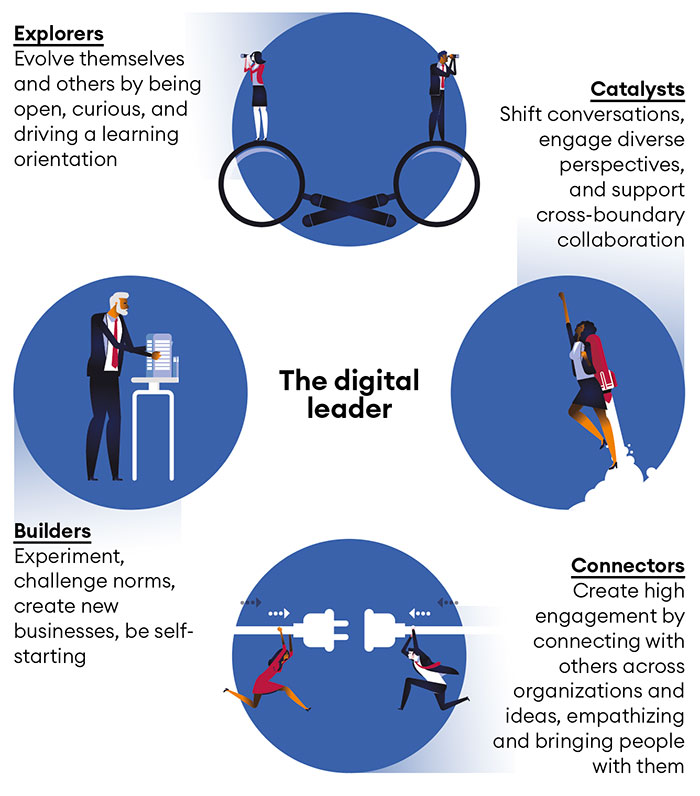
The new approaches in strategy, expertise and execution are underpinned by the digital leadership mindset. This is less about the mechanics of strategy and execution than about cultivating a leadership approach, which integrates new skills and expertise with an understanding of how the shift to the digital economy affects teams across all levels of an organization.
The most successful digital leaders incorporate four sets of behaviors: Builders, Catalysts, Explorers and Connectors.

Builders
The speed of competition in the digital economy is growing exponentially faster than it ever did in the analog economy. As a result, the half-life of both knowledge and products is continually reducing. In the digital economy, leaders develop and companies grow by building and experimenting, learning what does and doesn’t work across their customers, markets, business models, regulatory requirements and other considerations. Builders have hands-on experience of designing, deploying and scaling new digital businesses. These new businesses can take many forms and certainly do not need to be start-ups: the key is to have direct experience of the methodologies involved and all the varied trials and tribulations of building a business, so as to understand the nature of the challenge in developing new digital business models.
Experience as a Builder helps illuminate the difference between more innovation and invention – something that Google’s Wilson sees as an important difference. “People think of innovation as working on an idea and having something in a year, but innovation is about small course corrections. Invention is, ‘I don’t know what this is going to look like.’ You need to throw out the idea of a roadmap with milestones.”
This has implications for hiring decisions, he says, “You want to hire someone who wants to invent something, not just make 100 small changes to something. The companies heading towards trillion-dollar valuations continue to reinvent everything they do,” he continues. “You want a leader that wants to start all over, and start again.”

Explorers
Digital leadership involves challenging traditional models and approaches. The corollary is that leaders need to understand that the digital economy moves too quickly for any one person or team to have all the answers. Explorers create change by seeking to evolve themselves and those they work with, being open to new inputs and curious, creating a learning orientation. Jeremy Awori of Absa Bank Kenya describes this as “knowing what you know and being OK with what you don’t know. Learning is a must, listening is a must, adapting is a must.”
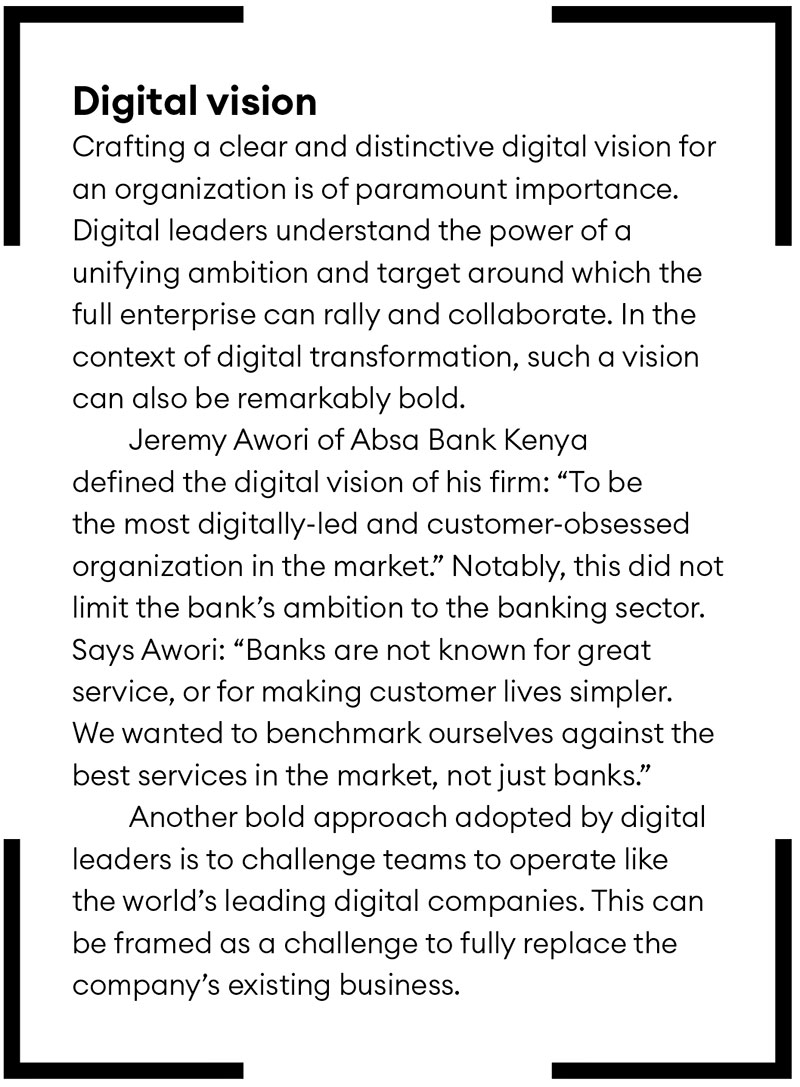

Catalysts
Digital leaders understand how to bring in diverse points of view and drive collaboration across teams, both internal and external to the enterprise. Christa Steele is an experienced San Francisco-based chief executive and is currently a director on several corporate boards. She says: “Digital is no longer the responsibility of one group – it involves and affects the full organization, from top to bottom. Empathy is very material, it can make or break a culture. You have to bring along the people that are reluctant to change.”
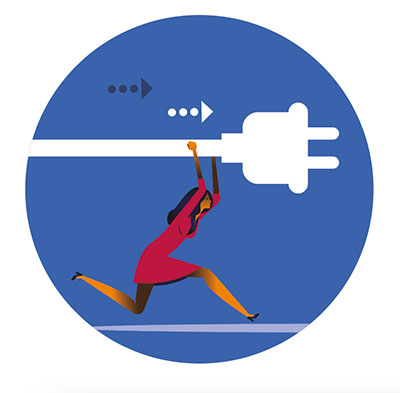
Connectors
Digital leaders know that for an organization to successfully transform and win in the digital economy, the entire enterprise needs to participate in the journey. Digital can be intimidating or outright threatening to many people. The best digital leaders understand that they need to ‘meet’ people on those concerns, regardless of where they are in their digital understanding. Connectors translate technical concepts into comprehensible frameworks and create a bridge for people to participate in the organization’s digital strategy.
The new digital leadership: speed + scale
Digital leadership should not be confused with technology expertise: understanding technology is not the same thing as running a business.
Steele reflects on her experience of hiring digital leaders: “If I’m looking for the ideal executive to take my company into the new digital age, they can’t just be technical – they have to be able to connect the dots across the enterprise and really understand how to lead an organization end-to-end, not just manage a process”. Her ideal digital leader is “someone who has managed a P&L [profit and loss statement], led operations and teams, understands integration, and – while being really good technically – doesn’t miss the bigger macro picture and how doing one thing will impact other things”.
Digital leaders need to combine two seemingly juxtaposed capabilities: the speed of invention and new value creation, and running businesses at scale. This ‘speed + scale’ model mirrors the exponentially more competitive market. To identify such ‘bilingual’ leaders, organizations regularly need to look beyond people with traditional career paths. As Wilson puts it: “Early in someone’s career you’re looking for self-starters. Later in a career, you want to understand what inventions they created, and if they spotted trends before others.”
Steele believes that “the most dynamic people have bounced around and done a whole bunch of things”. Typically, she says, they have “been involved in cutting-edge technologies” and “can brainstorm and problem-solve way beyond a typical person”. Ultimately, she says: “You’re looking for someone who can lead in a dynamic, ever-changing environment.”
Awori emphasizes the need to stretch leaders by getting them out of their comfort zones. “Look for opportunities for leaders to be uncomfortable, for leaders who are comfortable being uncomfortable and can make decisions without full data. See how your executives respond to that.”
Individuals with the digital leadership talent needed to spearhead digital programs remain rare. Consequently, more and more organizations understand that the enterprise-wide impact of digital means they need to develop digital leadership capabilities at scale. Andrew Maher, chief digital officer of the Asia-Pacific engineering and advisory firm Aurecon, summarizes the relationship between digital transformation and leadership development as follows: “If your business isn’t digital-native, any digital strategy with a likelihood of success needs to be a company-wide transformation. Your existing leadership group needs to understand the process for digital transformation from the outside-in. They need to know what your customers are asking for and what you can provide.”
To meet that need, Aurecon developed a digital literacy program (see box). The program recognizes how digital leadership differs from traditional leadership development. Liam Hayes, Aurecon’s chief people officer, says: “With digital technology advancing at such rapid rates, you must have emerging and current leaders continually learning. You can’t offer a one-day training program and think you are done or offer that exact same program year after year.” The work is never done, he adds: “You must continually invest and re-invest to develop the digital leaders of today and the future.”
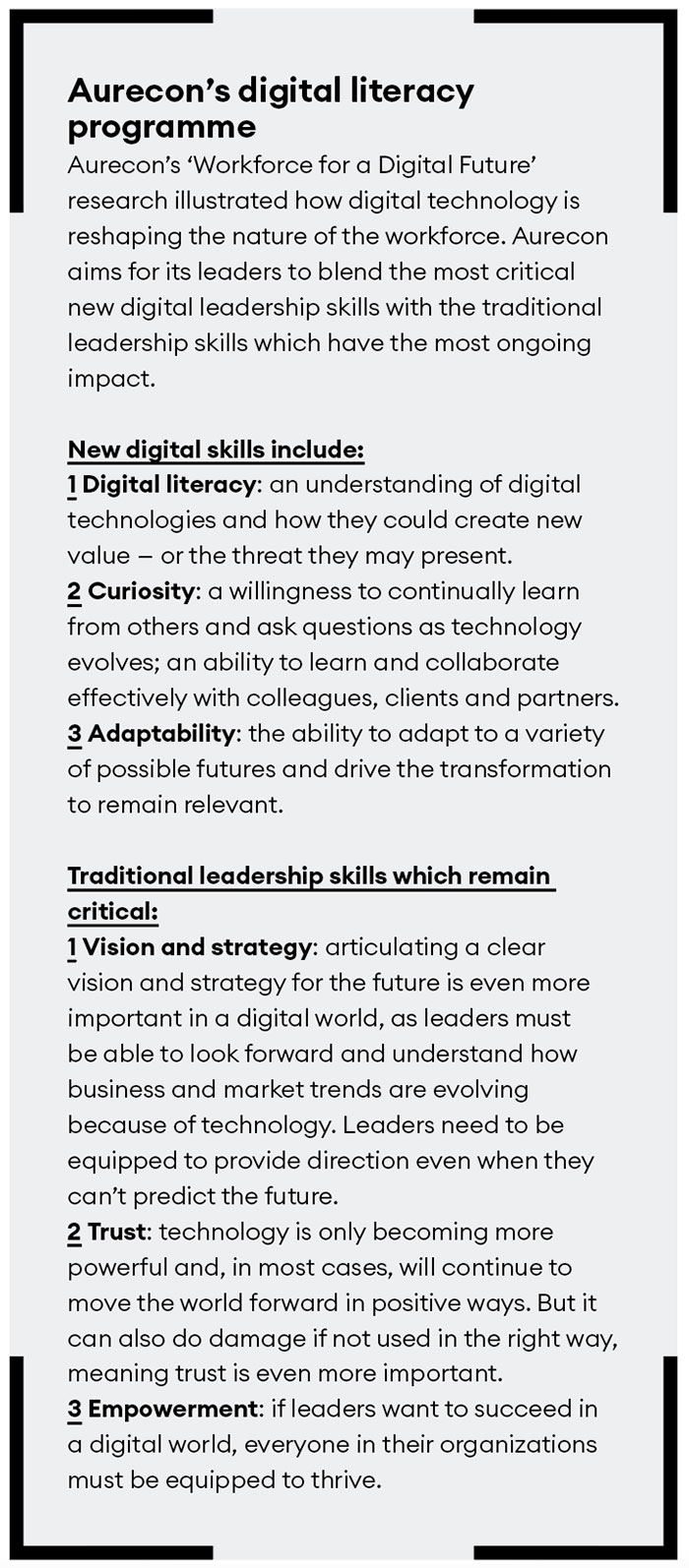
Digital leadership for today and tomorrow
The digital economy is driven by the never-ending emergence of new digital technologies which become continuously easier and cheaper to bring to market. While technology capabilities are necessary for winning in the digital economy, they are not sufficient to guarantee success or to differentiate your organization from its competitors. Companies win by creating strategies, which create new value through digital capabilities that blend speed and scale. Digital leadership is the core of this design and execution.
The need for organizations to digitally transform is urgent, and digital leaders are instrumental in guiding their organizations through this change. New strategies, new business models and new investment approaches all represent the leadership needed to meet today’s immediate, and in some cases existential, challenges.
To say that “transformation” is needed is not, however, to say that once change is accomplished organizations will return to stability, similar to the status quo of the analog economy. The digital economy will continue to demand more of organizations and their leaders.
Digital leadership represents the new core of leadership. These are the capabilities required by any organization seeking to win in the digital economy – and by all executives with ambitions to lead the way.




